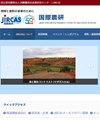日本科学家在CIMMYT对全球农业科学和小麦和玉米生产的贡献
IF 0.5
4区 农林科学
Q4 AGRICULTURE, MULTIDISCIPLINARY
引用次数: 0
摘要
国际玉米和小麦改良中心(CIMMYT)旨在主要通过发展中国家的小麦和玉米生产改善人类生计,特别是小农的生计。根据CIMMYT现有的文件,第一个在CIMMYT工作的日本人是1970年的实习生。从那时起,至少有10名实习生或中长期访问学生和14名来自日本研究所的任命或访问研究员在CIMMYT从事小麦和玉米研究。一些日本董事会成员和一位日本总干事也为CIMMYT的研究方向做出了贡献。日本研究人员和实习生为CIMMYT的研究和世界粮食生产做出了巨大贡献。研究内容包括玉米种质资源库、小麦快速育种/双单倍体技术、小麦持久抗病技术、小麦野生近缘耐热/抗旱技术、生物硝化抑制新性状和小麦赤霉病抗性新性状。全球小麦和玉米供应的前景并不乐观,而且由于世界人口的增加、高温和干旱的影响以及气候变化引起的新疾病的传播,未来将变得更糟。日本科学家在CIMMYT留下的科学成就可以在缓解这些问题方面发挥重要作用。附加关键词:遗传资源,耐久抗性,双单倍体,野生物种,生物硝化抑制本文章由计算机程序翻译,如有差异,请以英文原文为准。
Contribution of Japanese Scientists to Global Agricultural Science and Production in Wheat and Maize at CIMMYT
The International Maize and Wheat Improvement Center (CIMMYT) aims to improve human livelihoods, especially smallholder farmers’ livelihoods, through wheat and maize production mainly in the developing world. The first Japanese person to work at CIMMYT was an intern in 1970 according to existing CIMMYT documents. Since then, at least 10 interns or mid to long-term visiting students and 14 appointed or visiting researchers from Japanese institutes have worked on wheat and maize research at CIMMYT. Some Japanese board members and one Japanese Director General also contributed to the direction of CIMMYT’s research. i The Japanese researchers and intern students have contributed greatly to CIMMYT research and to world food production. The research includes maize germplasm genebank, rapid breeding/doubled haploid technology for wheat, durable disease resistance in wheat, wheat wild relatives for heat/drought tolerance and a new trait of biological nitrification inhibition and wheat fusarium head blight resistance. The outlook for global wheat and maize supply has not been optimistic and will become worse in the future due to an increasing world population, the impacts of heat and drought and the spread of new diseases caused by climate change. The scientific achievements left by Japanese scientists at CIMMYT can play an important role in mitigating these problems. Discipline: Crop Science Additional key words: genetic resources, durable resistance, doubled haploid, wild species, biological nitrification inhibition
求助全文
通过发布文献求助,成功后即可免费获取论文全文。
去求助
来源期刊
CiteScore
1.00
自引率
25.00%
发文量
42
审稿时长
>36 weeks
期刊介绍:
The Japan Agricultural Research Quarterly (JARQ) is a publication of the Japan International Research Center for Agricultural Sciences (JIRCAS), which provides readers overseas with the latest information on key achievements and developments in agricultural research in Japan, with the expectation that this information would contribute to the agricultural development of countries in tropical and subtropical regions.

 求助内容:
求助内容: 应助结果提醒方式:
应助结果提醒方式:


